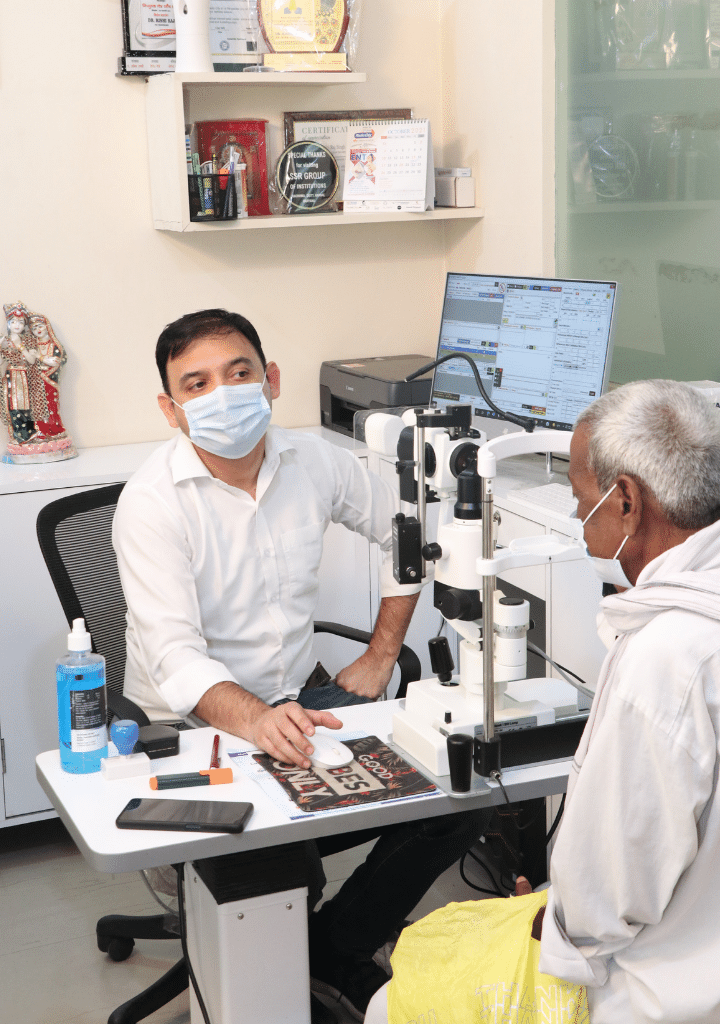Squint
- Home
- Squint
What is Squint ?
Squint, also known as strabismus, is not a disease in the traditional sense, but rather a visual condition characterized by misalignment of the eyes. In a person with squint, one eye may be positioned differently from the other, resulting in an inability of the eyes to work together in a coordinated manner. This misalignment can lead to problems with binocular vision (using both eyes together), depth perception, and even visual discomfort.
Squint can manifest in different forms, and the specific type depends on the direction in which one of the eyes deviates :
- Esotropia: One eye turns inward, towards the nose.
- Exotropia: One eye turns outward, away from the nose.
- Hypertropia: One eye turns upward.
- Hypotropia: One eye turns downward.
Squint can occur in people of all ages, including infants and children. If left untreated, it can lead to vision problems such as amblyopia (lazy eye), where the brain suppresses input from one eye to avoid confusion, resulting in reduced visual acuity in that eye.
The exact cause of squint can vary and may involve factors like muscle imbalances, problems with nerve control of eye muscles, refractive errors (nearsightedness, farsightedness, or astigmatism), and certain underlying medical conditions.
Treatment for squint depends on its underlying cause, severity, and the patient’s age. Options include :
- Corrective Lenses: Glasses can be prescribed to correct refractive errors, which may contribute to the squint.
- Patch Therapy: If amblyopia is present, patching the stronger eye to encourage the weaker eye to develop better vision may be recommended, especially in children.
- Vision Therapy: This involves exercises and activities aimed at improving eye coordination and focusing abilities.
- Surgery: In cases where non-surgical interventions are insufficient, eye muscle surgery can be performed to realign the eyes.
- Prism Lenses: Prism lenses can be used to redirect light entering the eyes, helping to reduce the appearance of misalignment.
Squint is a treatable condition, and early intervention is important, particularly in children, to prevent long-term vision problems and restore proper binocular vision. If you suspect you or someone you know has squint, it’s important to consult with an eye care professional, such as an ophthalmologist or a pediatric ophthalmologist, for an accurate diagnosis and appropriate treatment plan.
Book Now
Make An Appointment
For any kind of eye surgery or eye- checkup you do not need to go anywhere, you just need to make an appointment with our specialists and you will get answer of every eye-related problem.
Opening Hours
- 09:00 AM - 07:00 PM
- 09:00 AM - 07:00 PM
- 09:00 AM - 07:00 PM
- 09:00 AM - 07:00 PM
- 09:00 AM - 07:00 PM
- 09:00 AM - 07:00 PM
- 09:00 AM - 07:00 PM
Symptoms of Squint
Crossed Eyes
It is a condition in which the eyes do not match. That is, one eye is turning in a different direction than the other. Under normal conditions, the six muscles that control eye movement work together to keep both eyes pointing in the same direction.
Double Vision
Double vision occurs when a person sees a double image that should have only one. The two images can be side by side, one on top of the other, or both. This condition can affect your balance, movement, and your ability to read. Binocular diplopia only occurs when both eyes are open.
02
Uncoordinated Eye Movements
Each of your eyes sees a slightly different image. The brain combines these two images into a single three-dimensional image through a process called fusion. Good visual coordination will keep your eyes in the right place
03
Loss of Depth Perception
Sometime the eyes cannot see the depth of the visuals around. The lack of intensity belief decreases with the lack of visible contrast. Two wholesome functioning eyes are important for correct intensity belief. So, even supposing one eye is correct,
Changing Prescription of Specs
One of the number one worries of human beings getting new prescription glasses is the time it takes to get used to it. Sometimes, you may even discover that your imaginative and prescient is distorted,
05
FAQ
When to see a doctor for squint?
When you see that your friends and near and dears are noticing a squint or sometimes you may even notice is yourself, visit a specialist soon.
The management of squint is planned into two stages depending upon presence of refractive error and/or muscle weakness. first of all, a complete evaluation is done to see if there is any need of specs. We might see improvement in squint after proper use of prescription glasses. In second stage if the squint is not fully corrected even after using prescription glasses strabismus surgery for balancing of muscles is planned.
As such, squint surgery does not enhance vision and instead aligns the eye. Aligning the retina is critical for treating amblyopia (lazy eyes) in children that actually in a way helps in improving the vision of kids. This does, however, actually improves cosmesis in adults.
Squint may re-appear sometimes in later ages, which had been operated earlier. It needs to be thoroughly evaluated and accordingly a re-surgery may be needed.


